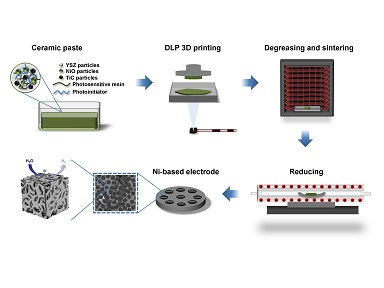Research Progress
Novel Approach to 3D Printed Nickel-based Electrocatalysts for Highly-efficient Hydrogen Evolution
date:
2022-08-12
Water electrolysis has proved to be an effective method of producing hydrogen employing renewable sources of energy, contributing the national commitment to carbon peak and carbon neutrality.
The development of cost-effective electrocatalysts for efficient and durable hydrogen evolution reaction (HER) in alkaline media is of vital importance to meet the increasing demand of hydrogen. The platinum group metals (PGMs) exhibit excellent activity towards the HER, but their high cost hinders their widespread application.
Motivated by such a challenge, a research team led by Prof. TANG Zhiyong and Associate Prof. ZHANG Jie at Shanghai Advanced Research Institute reported a novel photo-curing 3D-printing method to manufacture directly the structured nickel-based electrocatalysts with unique gluten-like cubic structure and strong catalyst-substrate interaction.
The research results were published in Nano Energy.
The photo-curing 3D printing has much lower manufacturing cost than the selective laser melting (SLM) 3D printing, and much higher degree of freedom and printing accuracy than that of direct ink writing (DIW) 3D printing.
Based on this technology, researchers optimized printing paste composition and post-treatment process. The resultant electrode surface exhibits gluten-like cubic structure, where Ti exists in amorphous state with strong interaction with Ni, leading to increased active sites and greatly improved electrolytic properties.
The tailored Ti-Ni NS electrode exhibits excellent durability and a remarkable low overpotential, surpassing the commercial Pt/C catalyst and most of the state-of-the-art electrocatalysts.
Density functional theory (DFT) calculations further reveal that the Ti doping significantly decreases the energy barrier of water dissociation and hydrogen energy barrier, thus enhancing the HER.
This work provides a novel strategy to precisely prepare the structured noble-metal-free catalysts with enhanced activity in alkaline water electrolysis(AWE). Moreover, the developed photo-curable 3D printing method provides an alternative option for manufacturing low-cost electrocatalysts with complex 3D architecture.

Schematic illustration of photo-curing 3D printing of Ni-based electrode (Image by SARI)





